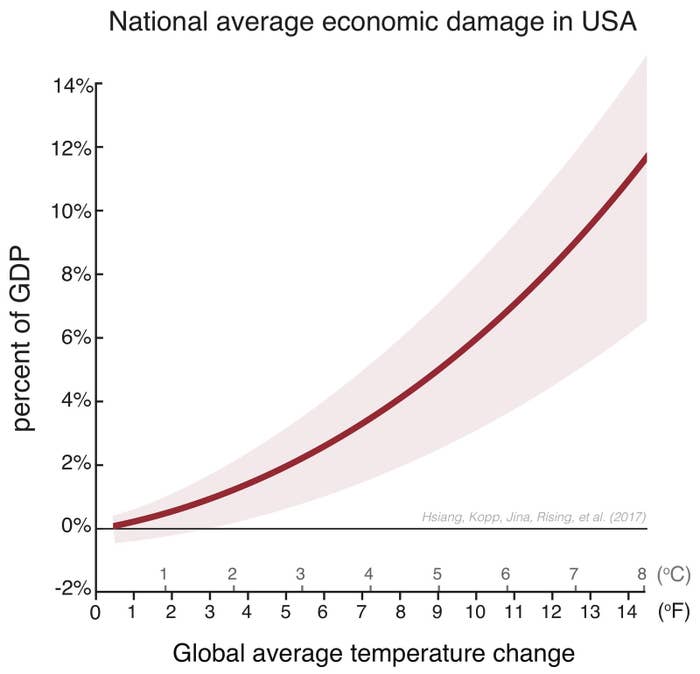Median US economic damages by county, predicted for 2080-2099, with continuing emissions. (Hsiang et al. 2017)
US counties face steep economic damages tied to future global warming, with the poorest counties to be hit hardest, according to a county-by-county analysis published on Thursday.
The warmer it gets, the worse that farms, businesses, and people will fare.
“As temperatures goes up, the economy gets damaged,” study author Amir Jina of the University of Chicago told BuzzFeed News, adding that “for each additional degree, there’s increasing damages done.”
The world has already warmed more than 1 degree Celsius in the industrial era, and scientists say manmade climate change is largely to blame. How much warmer it gets in this century depends on how quickly humans can bring down their greenhouse gas emissions. Most countries have set a shared goal of limiting future global warming below 2 degrees Celsius to prevent the worst climate impacts, under the 2015 Paris climate accord. The Trump administration announced the president's intention to withdraw from that accord in May.
The new findings, published in the journal Science, offer the most detailed breakdown available of the local economic impacts of climate change in the US.
The negative economic impacts won’t be felt equally by everyone. Poorer counties, which are largely clustered in the southern half of the US, are expected to experience the brunt of the damages. Unless countries meet their Paris goals, the poorest third of US counties could potentially see damages between 2% and 20% of their income in the second half of this century, according to the study.
One surprise, Jina said, “is the fact that the southern counties, which are already on average poorer, are going to suffer large damages.” Northern counties, in contrast, see only some damages and potentially even benefit from global warming.
Jina and his 11 colleagues analyzed how a changing climate would impact six areas of the US economy — agriculture, crime, coastal properties, electricity demand, human mortality, and labor supply — on a county-by-county level. The researchers focused on economic areas where the most complete data was available.
“This is truly an amazing study,” said Don Fullerton, a finance professor at the University of Illinois at Urbana-Champaign. “It’s the most detailed, comprehensive analysis anywhere ever of climate change damages in the United States.”
In the study, the scientists used real-world data to measure how weather and climate currently affect key areas of the economy. Using this same relationship, and holding population and economy constant at 2012 levels, they turned their attention to the future. They calculated different future warming scenarios using global climate models and projecting possible economic impacts.
When it comes to what sector is driving future damages, “the major impact is on mortality from heat,” said Fullerton, where higher temperatures can lead to more heat exhaustion and strokes. This largely explains the glaring gap between economic damages predicted for northern US counties versus southern US counties.
In many southern states, for example, summer daytime temperatures can frequently reach or exceed 95 or 100 degrees Fahrenheit. Those are already life-threatening temperatures for some people. With continued climate change, summer days there will get hotter and more deadly. In contrast, summer temperatures in the North are lower and won’t reach the same high temperatures as quickly.

While Fullerton doesn’t dispute the finding that soaring temperatures will threaten human health, triggering negative economic impacts, he suggested the study may be overstated. That’s in part because it does not account for how communities can — and likely will — adapt to future climate changes. More families and businesses may invest in air-conditioning, for example, to handle the heat.
For counties in southern states such as Florida, Georgia, and Texas, it’s not just the effects of rising temperatures on human health that have the potential to take a high economic toll. It’s also how sea-level rise and increasing storm intensity will threaten the economies of coastal communities. Jina described these places as facing a “perfect storm” of climate risks.
Meanwhile, in the Midwest, where Jina now lives, the big threat to the economy is how climate change will affect local agriculture.
“If you want to avoid the worst effects, we should aim to keep warming as low as possible,” Jina said.
